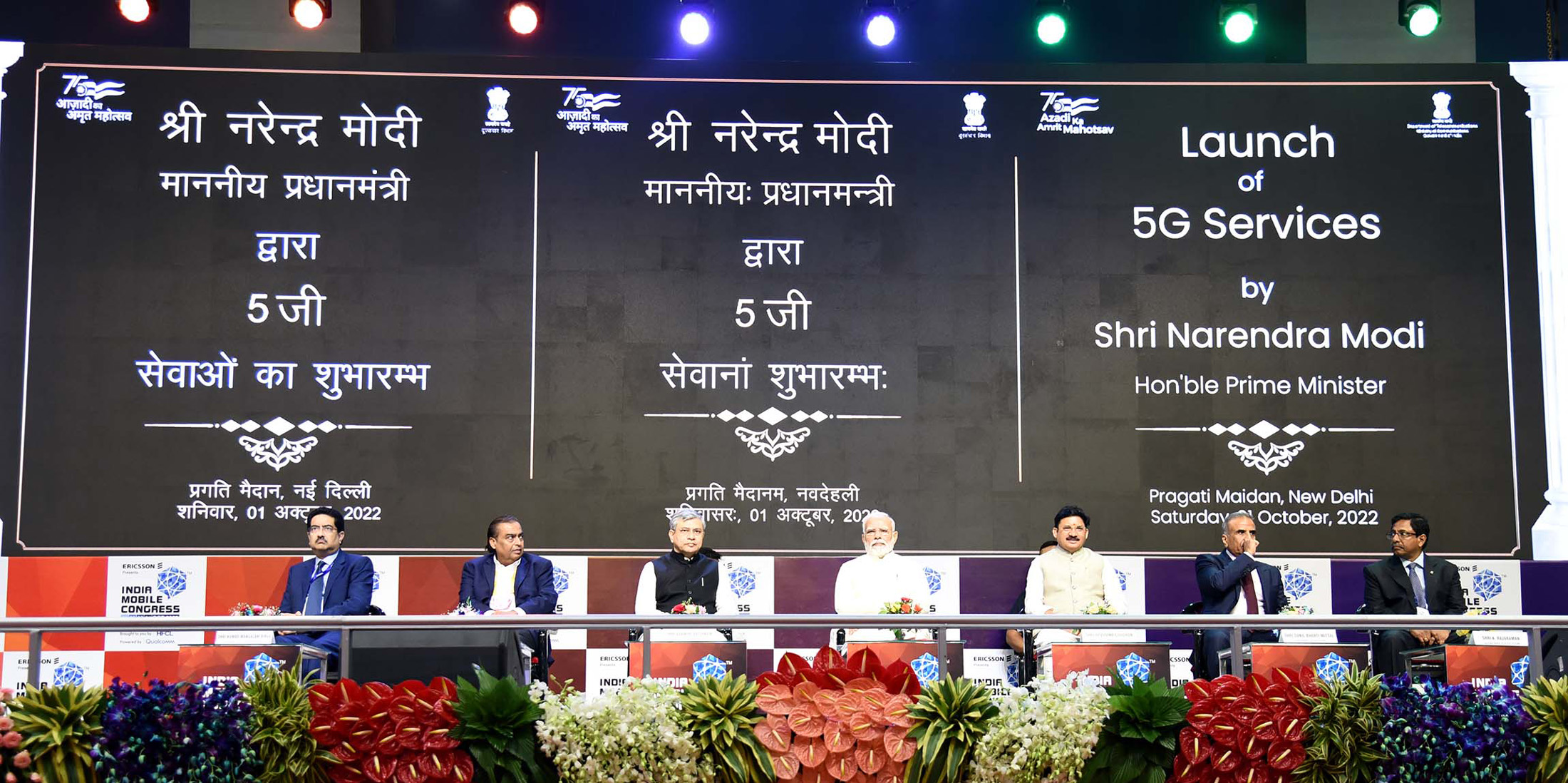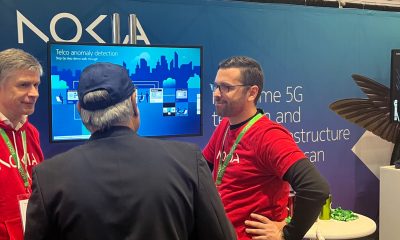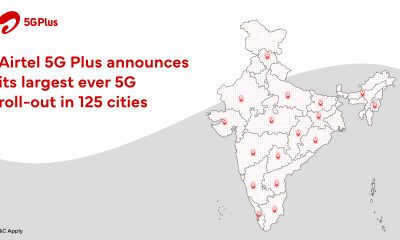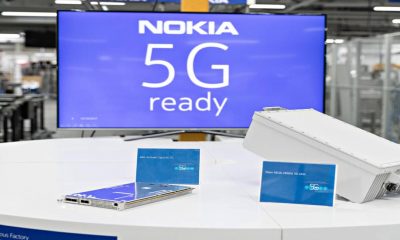5g
India launches 5G Services

NEW DELHI: Ushering in a new technological era, the Prime Minister, Narendra Modi launched 5G services in Pragati Maidan, New Delhi today. The Prime Minister also inaugurated the sixth edition of the India Mobile Congress and also witnessed the IMC Exhibition that was put on the occasion.
Industry leaders expressed their views on this historic occasion.
Mukesh Ambani, Chairman, Reliance, thanked the Prime Minister for inspiring the vision of a developed nation by 2047. “Every action and policy of the government is skillfully crafted to propel India, towards that goal. Steps taken to fast-track India’s march into the 5G era provide compelling proof of our Prime Minister’s determination”, he said.
Historic day for 21st century India! 5G technology will revolutionise the telecom sector. https://t.co/OfyAVeIY0A
— Narendra Modi (@narendramodi) October 1, 2022
He narrated the possibilities of 5G in key areas like education, education and climate etc. “Your leadership has raised India’s prestige, profile and power globally like never before. In today’s fast-changing world there will be no stopping a resurgent India from soaring to the top”, Shri Ambani concluded.
Sunil Bharti Mittal, Chairman, Bharti Enterprise remarked that the launch of 5G is the beginning of a new era and since it is happening during Azadi Ka Amrit Mahotsav, it makes it even more special. “With the efforts of the Prime Minister, this will usher new energy in the country. We are fortunate to have a leader in the Prime Minister who understands technology very minutely and deployed that to the development of the country in an unmatched manner”, he added.
Mittal further said that it will open up a sea of opportunities for people, especially in our rural areas. He recalled the Prime Minister’s initiatives in the field of infrastructure and technology from his Gujarat CM days. He said that during the pandemic, traffic shifted to villages and homes and the country’s heartbeat did not stop even for a second. Credit for that goes to the digital vision.
He also praised the audacity and achievement of the vision of Make in India.“Along with Digital India, the Prime Minister also took forward the Start-up India campaign and soon enough, India started producing unicorns”,
Mittal added, “With the advent of 5G, I’m sure that the country will add many more unicorns in the world.”
Kumar Mangalam Birla, Chairman, Aditya Birla Group called the advent of 5G a transformational event that proves India’s prowess on the global stage and reiterates the role of telecom technology as the bedrock of India’s growth. He thanked the Hon’ble Prime Minister Shri Narendra Modi for his vision and leadership for a generational leap in technology that has resulted in India making a mark on the global stage. He also thanked the Prime Minister for his inspirational role in supporting the telecom industry during the ongoing pandemic and for the path-breaking telecom reforms in the industry. Shri Birla said that the launch of 5G marks the beginning of an exciting journey for India. “We will see limitless potential for 5G development and use cases in the years to come”, he added.
The three major telecom operators of the country demonstrated one use case each in front of the Prime Minister to show the potential of 5G technology in India.
Reliance Jio connected a teacher from a school in Mumbai, with students in three different locations in Maharashtra, Gujarat and Odisha. This demonstrated how 5G will facilitate education by bringing teachers closer to students, obliviating the physical distance between them. It also demonstrated the power of Augmented Reality (AR) on screen and how that is being used to teach children across the country, remotely, without the need for an AR device.
The Prime Minister interacted with students from Dnyanjyoti Savitribai Phule School, Raigad, Maharashtra in presence of Maharashtra Chief Minister, Shri Eknath Shinde. Students from Ropda Primary School, Gandhinagar, Gujarat connected in presence of Gujarat Chief Minister, Bhupendra Patel.
The Prime Minister also interacted with students from SLS Memorial School, Myurbhanj, Odisha in presence of Odisha Chief Minister, Navin Patnaik. Abhimanyu Basu, Dhirubhai Ambani Int. School, BKC, Mumbai also demonstrated the use of 5G technology. The Prime Minister noted the enthusiasm of the students for technology in education. Author Amish Tripathi introduced the segment.
The Vodafone Idea test case demonstrated the safety of workers in an under-construction tunnel of Delhi Metro through the creation of a Digital Twin of the tunnel on the dias. Digital Twin will help give safety alerts to workers in real time from a remote location. PM took a live demo from the dias to monitor the work in real-time through utilising VR and Artificial Intelligence. The Prime Minister interacted with Shri Rinku Kumar, a worker in Delhi Metro Tunnel Dwarka, New Delhi in presence of Delhi Lieutenant Governor, Shri Vinai Saxena. The Prime Minister inquired about the user experience and learning curve needed to adopt the technology. He said that workers’ confidence in safety is the biggest contribution of new tech. He complimented the workers of India for their contribution to the nation’s growth.
In the Airtel demo, students from Dankaur, Uttar Pradesh witnessed a lively and immersive education experience to learn about the solar system with the help of Virtual reality and Augmented reality. A student Khushi, shared her experience of learning with the PM by appearing on the dias through a hologram. Uttar Pradesh Chief Minister, Shri Yogi Adiyanath connected from Rudraksh Convention Centre, Varanasi. The Prime Minister inquired if the VR education experience helped them understand the concepts in a comprehensive way. The student said that after this experience she is much more inclined toward learning new things.
Addressing the gathering the Prime Minister said that the Summit today might be global but its repercussions and directions are local. He said today is a special day for the fast-developing India of the 21st century. “Today, 130 crore Indians are getting a wonderful gift in the form of 5G from the country and from the telecom industry of the country. 5G is a knock on the doors of a new era in the country. “5G is the beginning of an infinite sky of opportunities. I congratulate every Indian for this.”, he added. He noted with satisfaction that in this launch of 5G and the march of technology, rural areas and workers are equal partners.
Stressing one more message of the 5G launch, the Prime Minister said” New India will not remain a mere consumer of technology, but India will play an active role in the development and implementation of that technology. India will play a big role in designing the future wireless technology, and manufacturing related to it.”The Prime Minister pointed out that India was dependent on other countries for 2G, 3G and 4G technologies. But with 5G, India has created a new history. “With 5G, India is setting a global standard in telecom technology for the first time”, he remarked.
Talking about Digital India, the Prime Minister said that some people think that this is just a government scheme. “But Digital India is not just a name, it is a big vision for the development of the country. The goal of this vision is to bring that technology to the common people, which works for the people, works by connecting with the people.”
Focussing on the need for a holistic approach to Digital India, the Prime Minister elaborated that “we focused on 4 Pillars, in four directions at once. First, the price of the device, Second, digital connectivity, Third, the cost of data, Fourth, and most importantly, the idea of ‘digital first’ .
Regarding the first pillar, the Prime Minister said that the low cost of devices can only be achieved through Aatmnirbharta. The Prime Minister recalled that there were only two mobile manufacturing units in India till eight years ago.
“These numbers have now gone up to 200”, Shri Modi said. The Prime Minister underlined that from exporting zero mobile phones in 2014, today we have become a mobile phone exporting country worth thousands of crores. “Naturally, all these efforts have had an impact on the cost of the device. Now we have started getting more features at a lower cost”, he added.
On the second pillar of digital connectivity, the Prime Minister informed that internet users have increased to 80 crores from 6 crores in 2014. From less than 100 panchayats in 2014 now 1.7 lakh panchayats are connected by optical fiber. “Just as the government started a door-to-door campaign to provide electricity, worked on the mission of providing clean water to everyone through the Har Ghar Jal Abhiyan, and delivered gas cylinders to the poorest of the poorest people through the Ujjwala scheme, our Government is working in a similar manner on the goal of Internet for all”, he said.
Regarding the third pillar, the cost of data, the Prime Minister said that the industry was given a slew of incentives and technologies like 4G received policy support. This brought down the price of data and a data revolution was ushered in the country. These three pillars started showing their multiplier effect everywhere, he said.
On the topic of the fourth pillar i.e. Idea of ‘Digital First’, the Prime Minister recalled the time when a handful of the elite class questioned if the poor would even understand the meaning of digital and doubted their potential, the Prime Minister said that he always had faith in the understanding, wisdom and inquisitive mind of the common man of the country. He said that he always found the poor of the country ready to adopt new technologies.
Highlighting the government’s efforts in the field of digital payments, the Prime Minister remarked that it was the government that went ahead and made the way for digital payments easier. “The government itself promoted citizen-centric delivery service through the app. Whether it is about farmers or small shopkeepers, we have given them a way to meet their daily needs through the app”, Shri Modi added. He recounted the seamless continuation of DBT, education, vaccination and health services, and work-from-home during the pandemic when many countries were finding it difficult to keep these services going.
Remarking that Digital India has given a platform, the Prime Minister said that small traders, small entrepreneurs, local artists and artisans can now market to everyone. Shri Modi added, “Today you go to a local market or vegetable market and see, even a small street vendor will tell you, not to transact in cash, but via ‘UPI’.” “This shows”, the Prime Minister added, “When a facility is available, thinking also gets emboldened”. The Prime Minister said when the government works with clean intentions, the intentions of citizens also undergo change. “This is the key difference in the intention (niyat) of 2G and 5G”, he remarked.
The Prime Minister said that the cost of data is among the lowest in the world. It has come down from 300 rupees per GB to about 10 rupees per GB. Remarking on the consumer-centric focussed efforts of the government, the Prime Minister said that the cost of data in India has remained very low due. The Prime Minister interjected, “It is a different matter that we did not make a fuss about, and did not launch big advertisements. We focused on how the convenience and Ease of Living of the people of the country increased.” “India may not have benefitted from the first three industrial revolutions, but I am confident that India will take full benefit of the 4th industrial revolution and, in fact, will lead it”, he added.
The Prime Minister informed that the use of 5G technology will not be limited to speedy internet access, but it has the capability to change lives. He said that we will see the promises of the technology realized in our lifetimes.
Modi urged the leaders of the telecom industry association to visit the schools and colleges of the country and unleash every aspect of this new technology. He also asked them to create an enabling ecosystem for MSMEs to prepare spare parts for electronic manufacturing.
“5G technology should be used to bring about a revolution in the country”, he remarked. The Prime Minister highlighted the use of drone technology that has been made possible after the newly launched Drone Policy.
He pointed out that many farmers have learnt how to fly drones and started making use of them to spray insecticides and pesticides in the fields. The Prime Minister assured one and all that India of the future will guide the world in the upcoming technology sector, in turn making India a global leader.
Union Minister of Communications, Ashvini Vaishnaw, Union Minister of State for Communications, Devusinh Chauhan, Chairman of Reliance Industries, Mukesh Ambani, Chairman of Bharti Enterprises, Sunil Mittal, Chairman of Aditya Birla Group, Kumar Mangalam Birla and Secretary, Department of Telecommunications, K Rajaraman were those present on the occasion.
Background
5G technology will offer a wide range of benefits to the common people. It will help in providing seamless coverage, high data rate, low latency, and highly reliable communications. Also, It will increase energy efficiency, spectrum efficiency and network efficiency. 5G technology will help in connecting billions of Internet of Things devices, will allow higher quality video services with mobility at high speed, and delivery of critical services such as telesurgery and autonomous cars among others. 5G will help in real-time monitoring of disasters, precision agriculture, and minimising the role of humans in dangerous industrial operations such as in deep mines, offshore activities etc. Unlike existing mobile communication networks, 5G networks will allow tailoring of requirements for each of these different use cases within the same network
The IMC 2022 is scheduled to be held from 1st to 4th October with the theme of “New digital Universe”. It will bring together leading thinkers, entrepreneurs, innovators, and government officials to discuss and showcase unique opportunities emerging from the rapid adoption and spread of digital technology.
5g
Ericsson has been ranked as the leader in the Frost Radar 5G Network Infrastructure Market 2024
For the fourth consecutive year, Ericsson has been ranked as the leader in the Frost
Radar™ 5G Network Infrastructure Market 2024 analysis, highlighting the impact of the
company’s strategy to meet the evolving needs of communications service providers (CSPs).
Maintaining top ranking in the Frost Radar™ report over the past years has shown that
Ericsson’s investments in R&D and across a wide product portfolio – which includes all areas
of 5G network infrastructure as well as previous generations of network infrastructure – is
valued in a market where technology is constantly evolving.
The report has also acknowledged Ericsson’s sustained focus on offering the latest and
lightest energy-saving products and solutions. It also touched on the company’s Open RAN
plans.
Fredrik Jejdling, Executive Vice President and Head of Networks at Ericsson, says: “The
latest Frost Radar report highlights our unwavering commitment to innovation and technology
leadership through the most competitive portfolio. In a challenging market, we remain
focused on our customers and move forward with even greater determination.”
Commenting on Ericsson’s top ranking, Troy Morley, Industry Principal, at Frost & Sullivan’s
Information & Communication Technology group, says: “Ericsson has done an excellent job
keeping its current customers and adding new customers, including significant replacement wins over competitors. Ericsson has a significant pipeline of customers that have yet to move
to 5G but will over the coming years.”

Ericsson currently powers *160 live 5G networks in 68 countries, which is the highest level
that Frost & Sullivan has seen publicly reported.
“Ericsson’s strategy continues to center on CSPs’ evolving needs in all areas of the world,”
Morley says. “However, with its 2020 acquisition of Cradlepoint, Ericsson also is expanding
its role with enterprise customers.”
The report has also discussed the importance of the open and virtual RAN movement and
the belief that eventually open and virtual RAN will be the norm. “Ericsson’s step into offering
Open RAN solutions in 2024 will help make this movement a reality,” Morley says. “The
company plans to offer O-RAN-compliant solutions in 2024; Frost & Sullivan believes this will
result in significant growth in open and virtual RAN revenue.”
Commenting further on the report, Morley says: “Energy efficiency has been a buzzword for
a few years and Ericsson continues to tout solutions that are smaller and lighter and that
save energy, answering its customers’ needs. This will continue with its traditional RAN
solutions and accelerate with its new Open RAN offerings.”
The Frost Radar report measures growth rates in addition to absolute revenue and combines
them with several other factors to measure companies’ performance along the Growth Index.
The report also measures innovation for each company by assessing its product portfolio, the
scalability of its innovations, the efficacy of its R&D strategy, and several other factors.
The latest report from business consulting firm Frost & Sullivan reaffirms Ericsson’s
leadership in the 5G network infrastructure market, which spans radio access networks
(RAN), transport networks, and core networks.
5g
Ericsson Showcases differentiated connectivity for the value of 5G

Ericsson (NASDAQ: ERIC) showcased its advanced 5G connectivity solutions and innovative 5G use cases based on differentiated connectivity at the Ericsson Imagine Live Roadshow today. Ericsson has announced the launch of a new software toolkit to strengthen 5G Standalone network capabilities and enable premium services with differentiated connectivity. The portfolio enhancement comes as the growth of new use cases and rising mobile user expectations on the quality of 5G experience are putting greater demands on network capacity and performance.
In the ‘Capture the value of 5G’ zone, experience sports like never before with the Enhanced Sports Experiences demo, where a feature-rich app allows sports clubs to engage directly with their vast fan bases, creating new revenue streams. Leveraging network slicing and APIs, service providers can ensure the ultimate fan experience and gain revenue share.In 2024, Ericsson is extending CSP slicing subscriptions to include micro-payments for short-term connectivity needs.
Another demo called Superior Uplink for Live streams, offers seamless real-time livestreaming via commercially available smart glasses, overcoming the hindrance of 5G upload speeds with Uplink Carrier Aggregation. This technology boosts upload speeds by combining frequencies, enhancing performance, promoting Standalone 5G adoption, and optimizing spectrum utilization.
In the ‘Programmable Networks’ zone, we’re showcasing how Ericsson is transforming the mobile network landscape by enabling elevated service differentiation for premium 5G experiences with Service Level Agreement assurance, revolutionizing CSP offerings. Ericsson’s new software toolkit with advanced RAN and Core capabilities empowers CSPs to seize growth opportunities by providing differentiated connectivity at scale. Another demo showcases how our RedCap technology supports CSPs’ business growth by reducing the complexity and size of device platforms for mid-tier use cases, expanding the 5G ecosystem to cater to diverse connectivity needs across consumer and enterprise/industrial segments on both FDD and TDD bands.
The ‘Enterprise Transformation’ zone showcases how critical infrastructure industries such as power plants, wind farms, and oil refineries can enhance worker safety and efficiency with our private 5G networks use case demos. Partnering with RealWear and OverIT, we enable secure, reliable, realtime access to complex data in order to provide an immersive connected worker experience for use in hazardous environments where accurate positioning and the ability to handle a high density of connected devices is required.
In the ‘Shape our Future Together’ zone, we’re building on the successful API showcase at Mobile World Congress 2023 with partners like Zoom and Blacknut. This year we are demonstrating high-demand use cases with world-leading brands such as Toyota and Sony using QoD API with network slicing. This underscores Ericsson’s thought leadership in the Network API and 5G monetization space, aligning with our strategy to build a platform business and our vision of industry cooperation with strong partners.
5g
MediaTek Catch-up with Tech: Infinix Zero 30 5G with Dimensity 8020 launched

NEW DELHI: Chipset maker MediaTek, which claims to power more than two billion connected devices every year, hosted ‘Catch-up with Tech’ in collaboration with handset brand Infinix on August 28 to share insightful and engaging conversations about the new-age smartphones and innovative technologies powering everyday lives.
The meet-up threw the spotlight on the MediaTek Dimensity Auto, Satellite solutions and Generative AI along with an extensive showcase of newly-launched Infinix Zero 30 5G powered by MediaTek Dimensity 8020, Infinix GT 10 Pro powered by MediaTek Dimensity 8050, and Infinix QLED TV powered by MediaTek.
In terms of specs, the Infinix Zero 30 5G is tailored for young storytellers and creators, featuring the first-ever smartphone to deliver 4K 60fps video recording from its 108 MP OIS rear camera and ultra-high resolution 50MP front camera. The Zero 30 series powered by MediaTek Dimensity 8020 is said to be a game changer for the front camera vlogging experience along with being the slimmest curved AMOLED smartphone in the segment with glass and a vegan leather back panel. It also claims to be one of the most premium-looking devices in the segment.
The event witnessed a panel discussion moderated by Anuj Sidharth, Deputy Director Marketing & Corporate Communications, MediaTek and included expert panelists from Infinix, MediaTek and two renowned professional photographers.
“With the fifth edition of Catch-up with Tech, we aim to bring consumers closer to the technology and enable them to make informed buying decisions based on their diverse needs. In collaboration with Infinix, this meet-up is in-line with MediaTek’s vision of technology democratization and making innovative technology accessible to everyone,” said Anku Jain, Managing Director, MediaTek India. “The MediaTek Dimensity 8020 in Infinix Zero 30 5G brings faster displays, brilliant cameras and ultra-fast performance. Further, MediaTek Imagiq technologies enrich the capture experience by combining dedicated AI, imaging processors and accelerators to provide incredible results,” he added.
Anish Kapoor, CEO, Infinix Mobile India, said, “Featuring India’s first 50MP 4K 60 fps video recording, Infinix Zero 30 5G is primed to redefine smartphone imaging capabilities, setting a new standard for the creators and vlogging enthusiasts. Our collaboration with MediaTek has played a pivotal role in shaping our exceptional smartphone portfolio, and the Zero 30 5G stands as evidence of our unwavering commitment to innovation and delivering unmatched experiences to our users. The display and design of the device represent a leap forward in smartphone technology. As Infinix Zero 30 5G hits the shelves, we are positive that our customers will find this new offering as exhilarating as we do, further empowering creators to capture their story like never before.”
Radhakrishnan Chakyat, a photography evangelist, founder and host of Pixel Viilage, said, “Infinix Zero 30 5G smartphone powered by MediaTek Dimensity 8020 chipset has amazing hardware features, an excellent camera, dual-view video mode and is primed for optimal content creation and saves a tremendous amount of editing time.”
Aarzoo Khurana, a wildlife photographer, said, “Over the last few days, I clicked various pictures and recorded a few videos with the newly-launched Infinix Zero 30 5G powered by MediaTek Dimensity 8020, and the experience has been truly inspiring. Infinix’s smartphone’s OIS feature helps content creators click shake-free pictures and the front camera, which is extremely sharp and detailed, enables content creators to click countless selfies.”
-

 News3 weeks ago
News3 weeks agoMobile tariff hike:Congress blames NDA government for Rs 34,824 crore burden on public
-

 News7 months ago
News7 months agoYotta’s Cloud Data Center in GIFT City, Gujarat goes live
-

 5g2 months ago
5g2 months agoEricsson Showcases differentiated connectivity for the value of 5G
-
5g2 months ago
Ericsson has been ranked as the leader in the Frost Radar 5G Network Infrastructure Market 2024
-

 News1 month ago
News1 month agoIndian Tech Startups Surge Ahead with $4.1 Billion in Funding for H1 2024












